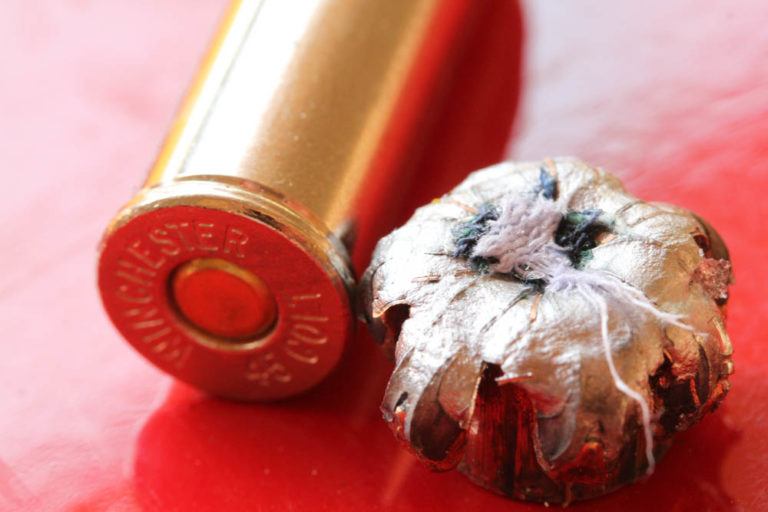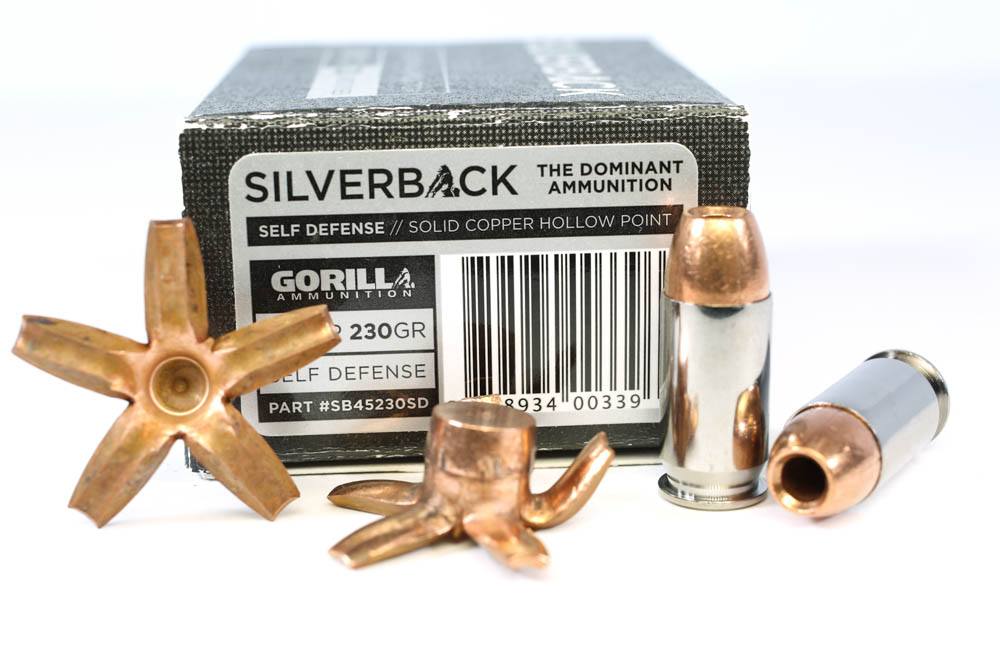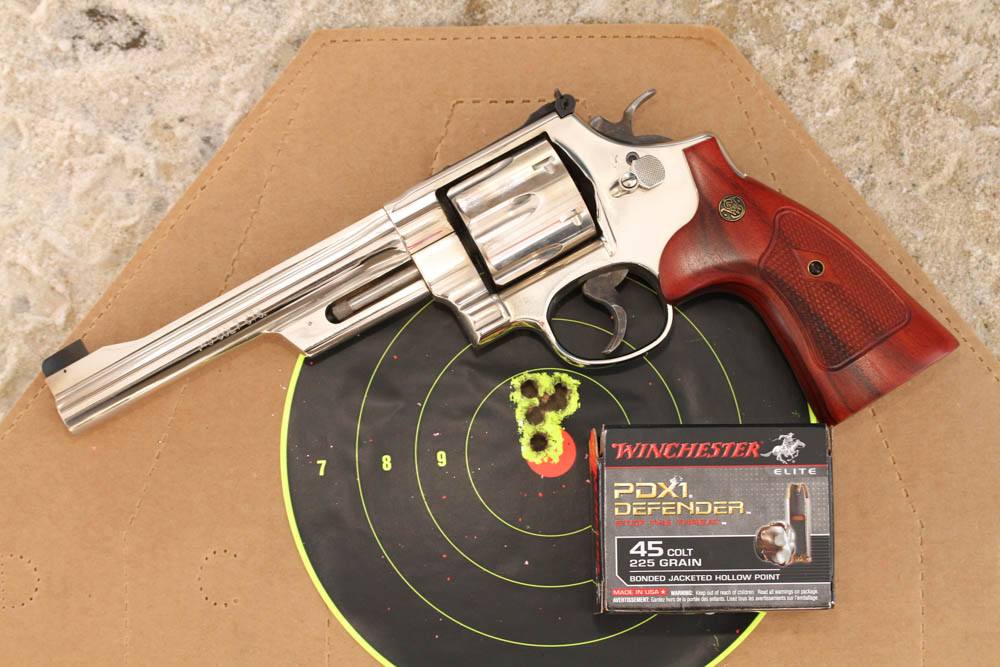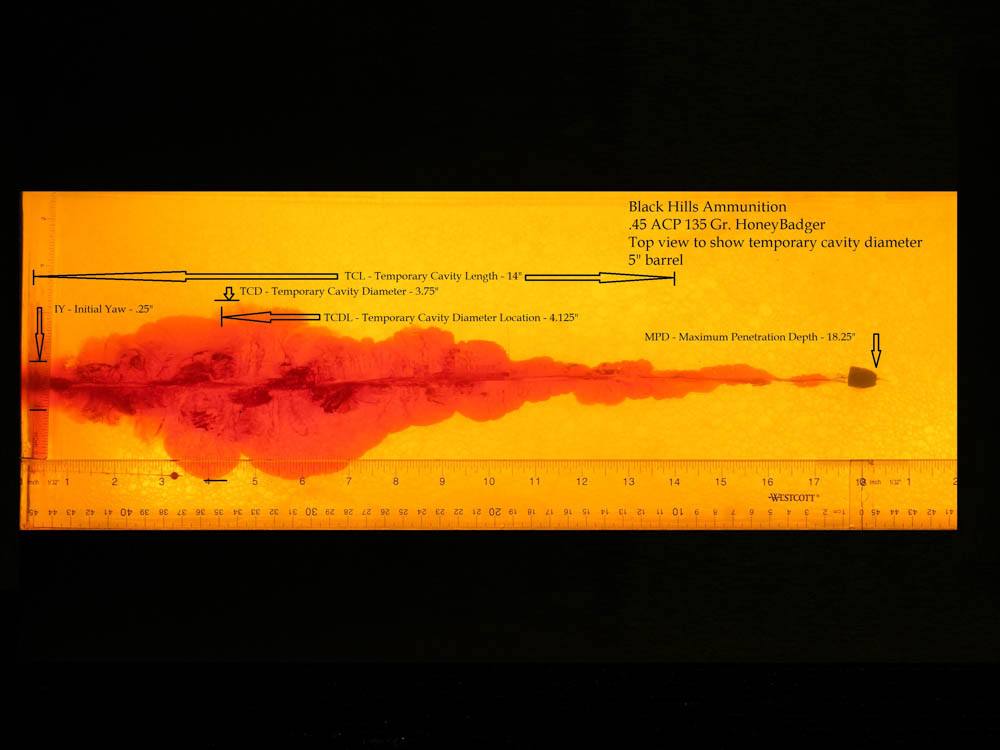
The problem with the .45 ACP for self-defense isn’t the cartridge, but the pistols that chamber it. It’s a big cartridge and requires a big pistol. Even the most compact .45s are still kind of big, and the smallest are harder to shoot as a result.
Because, they don't make a .46:
- Any modern bullet in .45 ACP will easily pass the FBI test.
- It is a very efficient cartridge that delivers a bullet capable of eye-popping expansion.
- You probably don’t need +P, but some want it, so there it is.
- The .45 Colt smacks the FBI tests with authority, and delivers plenty of expansion.
- As with other big bores, with ACP and Colt 45s, bullet weight isn't as important.
The obvious topic for discussion here is the .45 ACP. But, let us not forget the .45 Colt, which has been seeing some resurgence. First, the .45 ACP.
When the FBI was trying to find something better after the Miami shootout, there were those counseling the .45. However, there was a lot of resistance to jumping up to it and it alone. A lot of agents simply wouldn’t be able to handle a .45 ACP, especially since the two choices were the 1911 and the S&W 645. Both big guns, they would have been too big for the smaller agents, and the recoil would have been too much for even those who weren’t small.
The FBI had just settled a case where the training program, as it existed at that time (the early 1980s), flunked female candidates, candidates who would have passed the FBI qual course had they been given the qual course and not the academy course. The FBI was sensitive about disparate impact.

So, they selected the 10mm, and wrangled and fought and changed plans. They could have avoided all that, and the subsequent 25 years of wandering in the wilderness with .40s, if they had simply opted for the .45 (the 10mm had to be in a .45-sized pistol anyway), figured out how to build guns for female and small-handed agents, and taught them how to shoot.
All the R&D and bullet technology that improved the 9mm and .40 translated perfectly to the .45, and as a result, it is even better now than it was back in the 1980s.
The problem with the .45 ACP isn’t the cartridge, but the pistols it is in. It is a big cartridge and requires a big pistol. Even the most compact .45s are still kind of big, and the smallest are harder to shoot as a result.
So here, your choices are easy in ammo and hard in pistol.

Any modern bullet in .45 ACP will easily pass the FBI test. The .45 is also amenable to the adoption of the new hollowpoint all-copper bullets. There, you can get impressive, even eye-popping expansion out of bullets – with petals expanding to over three-quarters of an inch.
Where the old wound tracks of FMJ, also known as hardball, were simply .45 diameter tunnels, the new bullets expand and create impressive wound tracks.
Raise Your .45 ACP IQ:
- Fading Away? The .45 ACP Isn’t Going Anywhere
- 10 Top .45 Pistol Options For Any Budget
- .45 ACP vs 9mm: Which Is Better?
- 10mm Vs .45 ACP: Making the Right Choice
The .45 is also a very efficient cartridge. The bullet is mostly inside the case, and the case capacity is well suited for the bullet. (That was a point considered in the first decade of the 20th century, when the .45 ACP was developed.) It doesn’t take a lot of powder to get its bullet up to speed, and as it does its work through mass and frontal area, even if they didn’t expand much, they’d still be great. That they do is a grand bonus.
GUARD DOG
Even more so than the .40, the Guard Dog in .45 is a great choice. If you are limited to FMJ, this delivers 165 grains of soft-recoiling .45 bullet, and the expanding full metal jacket is a bonus.
.45 ACP+P?
Do you need the extra boost of P? Maybe. If you can handle it, if it doesn’t cause a decrease in your shooting and you want the extra performance, then go for it. You probably don’t need it, but some want it, so there it is.

.45 COLT
The .45 Colt dates back to 1873 and the Colt Single Action Army. It has an MAP of only 14,000 PSI, but that’s plenty. Given a .45 bullet of full weight, the .45 Colt smacks the FBI tests with authority, and delivers plenty of expansion. And since the pressure is so low, you can get a lifetime of shooting out of one revolver, as it simply isn’t worked that hard by the recoil or pressure. You just have to be willing to put up with a full-sized revolver, is all.
Back when Detroit PD allowed personal sidearms in calibers officers could shoot a passing score with, we saw bunches of S&Ws in .45 Colt on the street. Back before the FBI tests, a flat-nosed 255-grain lead bullet was well thought-of, and it should still be so today.
FUTURE
If something works in 9mm, it works better in .40, right? Then it obviously should work better still in .45 ACP, because we have it all – mass, frontal area, and we aren’t giving up velocity. I speak of the Honey Badger, which does not expand, stops in gel like bonded bullets, and ignores barriers. This just may be what all bullets are in the future.

SELECTION
As with the other big-bore choices, you do not have to obsess about weight. 185s work as well as 230s, and if your handgun (or your hands) prefer the 185s over the 230, then go for it. Don’t get hung up on bullet weight, go with accurate and easy to shoot.
Editor's Notes: This article is an excerpt from Choosing Handgun Ammo: The Facts That Matter Most for Self-Defense by Patrick Sweeney.

Next Step: Get your FREE Printable Target Pack
Enhance your shooting precision with our 62 MOA Targets, perfect for rifles and handguns. Crafted in collaboration with Storm Tactical for accuracy and versatility.
Subscribe to the Gun Digest email newsletter and get your downloadable target pack sent straight to your inbox. Stay updated with the latest firearms info in the industry.

![Best Concealed Carry Guns In 2025 [Field Tested] Wilson Combat EDC X9S 1](https://gundigest.com/wp-content/uploads/Wilson-Combat-EDC-X9S-1-324x160.jpg)


![Best 9mm Carbine: Affordable PCCs [Tested] Ruger Carbine Shooting](https://gundigest.com/wp-content/uploads/Ruger-Carbine-Shooting-100x70.jpg)
![Best AR-15: Top Options Available Today [Field Tested] Harrington and Richardson PSA XM177E2 feature](https://gundigest.com/wp-content/uploads/Harrington-and-Richardson-PSA-XM177E2-feature-100x70.jpg)

Patrick, considering the 1911’s sometimes finicky eating habits, the Honey Badger’s bullet shape looks like a jam promising to happen. It would make no sense for this to be true for the product and it still marketable, and your review made no mention of feeding problems, but how rigorous has testing been?
I am a long time Ruger single action Blackhawk owner, owning both a 357 Mag and a stainless convertible 45 Colt (switchable cylinders between 45 ACP and 45 LC). I think this article does a really good job of describing the differences between these common calibers, and the 45 LC is often left out! Of course, the 45 LC is not a semi-auto handgun ammo, but the 45 ACP, and can be fired in both revolvers and semi-autos.
The 357 Mag (mentioned very briefly here) has the largest range of pre-manufactured ammo power wise or all calibers, and tops off at a hefty 900 ft. lbs. of ME, so these kick more than any of the 45 ACP cartridges, even those that go up to 616 of ME ft. lbs. (a 185 gr bullet). The 357 Mag should always be considered when looking at revolvers. But the 45 Colt ammo has the most power, at 1215 of ME ft. lbs. with the most kick (a 260 gr bullet). There is even a 1300 ft. lb. 45 LC ammo made by Buffalo Bore as well, but I have not shot that cartridge. While the very high powered ammo is fun to shoot, I can only shoot one or two rounds before my hand gets tired/sore! But I do not have this issue with any of the 357 Mag ammo, nor with any of the 45 ACP +P ammo. I find it hard to understand why the military switched from the very successful (really did its job) to the pretty weak 9mm handguns. Was this just for compatibility’s sake with the ammo from other countries?
VinnyL (02-05-2018)
all modern defensive calibers bigger than .380 are good enough…including .380
An additional option as discussed By Bob Campbell published on September 17, 2014 in Firearms
The GLOCK .45 GAP
For several years, GLOCK listened to police agencies say they wanted to adopt a .45-caliber pistol since the GLOCK 21 did not offer the best hand fit. As a result, GLOCK and Speer Ammunition developed the .45 GLOCK Automatic Pistol (.45 GAP) cartridge.
The .45 GAP is similar to the .45 ACP although uses a shorter case, which allows the cartridge to be chambered in compact handguns of basically 9mm size. While the slide is heavier, the GLOCK Model 37 .45 GAP is barely larger than the GLOCK 17 pistol in 9mm. That is possible due to the special short case and low pressure of the .45 GAP cartridge.
Like the .45 ACP, the .45 GAP works at modest pressure: The .45 ACP operates at about 21,000 psi, while the .40 and 9mm can operate at well more than 30,000 psi. The .45 GAP is rated at 23,000 psi, or about the same pounds-per-square inch pressure as a .45 ACP +P loading. The .45 GAP uses a special extractor groove considerably different from the .45 ACP and a small pistol primer rather than the large primer of the .45 ACP. The .45 GAP is similar to the .45 ACP, but the cartridge is unique.
NYSP Superintendent Wayne E. Bennett announced Nov. 9, 2006, that the agency would purchase 5,400 GLOCK Model 37 pistols in .45 GAP caliber. I have fired and examined the pistol and agree with the agency’s findings.
The Model 37 full size and Model 38 compact pistols fit most hand sizes well.
The pistol does not overly challenge a novice nor limit an expert.
The effective ballistics of the .45 GAP involve a 185-grain or 200-grain bullet at about 1,000 feet per second (fps).
My personal test pistol exhibited a velocity of 1,050 fps with the 185-grain Gold Dot load and 1,010 fps with the 200-grain load.
I mentioned hand fit compared to the Model 21 .45, so the measurements are listed here.